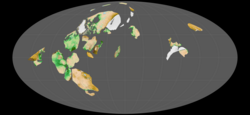Earth:Statherian
| Statherian | |
|---|---|
| 1800 – 1600 Ma | |
 Map of Earth during the Statherian, c. 1740 Ma | |
| Chronology | |
| Etymology | |
| Name formality | Formal |
| Usage information | |
| Celestial body | Earth |
| Regional usage | Global (ICS) |
| Time scale(s) used | ICS Time Scale |
| Definition | |
| Chronological unit | Period |
| Stratigraphic unit | System |
| Time span formality | Formal |
| Lower boundary definition | Defined chronometrically |
| Upper boundary definition | Defined chronometrically |
The Statherian Period ( /stəˈθɪəriən/; Ancient Greek:, meaning "stable, firm") is the final geologic period in the Paleoproterozoic Era and lasted from 1800 Mya to 1600 Mya (million years ago). Instead of being based on stratigraphy, these dates are defined chronometrically.[2][3]
The period was characterized on most continents by either new platforms or final cratonization of fold belts. Oxygen levels were 10% to 20% of current values.[4]
Rafatazmia, controversially[5] claimed to be present in Statherian beds in India , may be the oldest known confirmably eukaryotic fossil organism.[6]
By the beginning of the Statherian, the supercontinent Columbia had assembled.[7]
Approximately 1.7 billion years ago, a series of natural nuclear fission reactors was operational in what is now Oklo, Gabon.[8]
See also
- Earth:Boring Billion – Earth history, 1.8 to 0.8 billion years ago
References
- ↑ 1.0 1.1 Plumb, K. A. (June 1, 1991). "New Precambrian time scale". Episodes 14 (2): 139–140. doi:10.18814/epiiugs/1991/v14i2/005.
- ↑ "Statherian Period". GeoWhen Database. http://www.stratigraphy.org/geowhen/stages/Statherian.html.
- ↑ James G. Ogg (2004). "Status on Divisions of the International Geologic Time Scale". Lethaia 37 (2): 183–199. doi:10.1080/00241160410006492.
- ↑ Holland, Heinrich D. (2006). "The oxygenation of the atmosphere and oceans". Philosophical Transactions of the Royal Society: Biological Sciences 361 (1470): 903–915. doi:10.1098/rstb.2006.1838. PMID 16754606. PMC 1578726. http://rstb.royalsocietypublishing.org/content/361/1470/903.full.pdf.
- ↑ Kumar, S. (2009). "Controversy concerning 'Cambrian' fossils from the Vindhyan sediments: a re-assessment". Journal of the Palaeontological Society of India 54 (1): 115–117. http://palaeontologicalsociety.in/vol54_1/v10.pdf.
- ↑ Bengtson, Stefan; Sallstedt, Therese; Belivanova, Veneta; Whitehouse, Martin (2017). "Three-dimensional preservation of cellular and subcellular structures suggests 1.6 billion-year-old crown-group red algae". PLOS Biology 15 (3): e2000735. doi:10.1371/journal.pbio.2000735. PMID 28291791.
- ↑ Zhao, Guochun; Cawood, Peter A; Wilde, Simon A; Sun, Min (November 2002). "Review of global 2.1–1.8 Ga orogens: implications for a pre-Rodinia supercontinent". Earth-Science Reviews 59 (1–4): 125–162. doi:10.1016/S0012-8252(02)00073-9. Bibcode: 2002ESRv...59..125Z.
- ↑ Davis, E. D.; Gould, C. R.; Sharapov, E. I. (1 April 2014). "Oklo reactors and implications for nuclear science". International Journal of Modern Physics E 23 (4): 1430007–1430236. doi:10.1142/S0218301314300070. Bibcode: 2014IJMPE..2330007D.
 |
